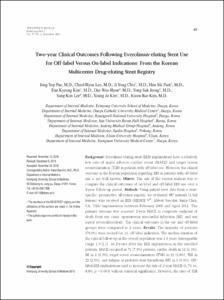Two-year Clinical Outcomes Following Everolimus-eluting Stent Use for Off-label Versus On-label Indications: From the Korean Multicenter Drug-eluting Stent Registry
- Journal Title
- Keimyung Medical Journal
- Issued Date
- 2018
- Volume
- 37
- Issue
- 2
- Abstract
- Background: Everolimus-eluting stent (EES) implantations have a relatively
low rate of major adverse cardiac event (MACE) and target lesion
revascularization (TLR) in patients with off-label use. However, the clinical
outcome in the Korean population regarding EES in patients with off-label
use is not well known. Objects: The aim of the current analysis was to
compare the clinical outcomes of on-label and off-label EES use over a
2-year follow-up period. Methods: Using patient-level data from a stentspecific,
prospective, all-comer registry, we evaluated 987 patients (1,342
lesions) who received an EES (XIENCE VⓇ, Abbott Vascular, Santa Clara,
CA, USA) implantation between February 2009 and April 2011. The
primary outcome was assessed: 2-year MACE (a composite endpoint of
death from any cause, spontaneous myocardial infarction (MI), and any
repeat revascularization). The clinical outcomes in the on- and off-label
groups were compared at 2 years. Results: The majority of patients
(79.0%) were treated for ≥1 off-label indication. The median duration of
the clinical follow-up in the overall population was 2.0 years (interquartile
range 1.9–2.1). At 2-years after the EES implantation in the enrolled
patients, MACE occurred in 71 (7.9%) patients, cardiac death in 12 (1.3%),
MI in 4 (0.5%), target vessel revascularization (TVR) in 33 (3.8%), TLR in
22 (2.5%), and definite or probable stent thrombosis (ST) in 1 (0.1%). Offlabel
EES implantations tend to increase the risk of 2-year MACE (4.7% vs.
8.8%, p = 0.063) without statistical significance. However, the rates of TLR
were higher in the off-label EES implantations (0.0%
vs. 3.2%, p = 0.013). In the multivariable analysis,
renal failure, previous bypass surgery, previous
cerebrovascular accident, and left main lesions were
associated with 2-year MACE in patients with EES
implantations. Conclusions: The incidence of 2-year
MACE was 7.9%, which that might be acceptable in
all-comer patients treated with EES implantations.
Although the off-label use of EES was not statistically
associated with an increased risk of MACE, the TLR
rate was higher in the off-label group, suggesting that
physicians need to pay attention to high risk patients
with the use of EES implantations.
- Publisher
- Keimyung University School of Medicine
- Citation
- Ji Yong Choi et al. (2018). Two-year Clinical Outcomes Following Everolimus-eluting Stent Use for Off-label Versus On-label
Indications: From the Korean Multicenter Drug-eluting Stent Registry. Keimyung Medical Journal, 37(2), 49-60-49–60.
- Type
- Article
- Appears in Collections:
- 2. Keimyung Medical Journal (계명의대 학술지) > 2018
Items in Repository are protected by copyright, with all rights reserved, unless otherwise indicated.
